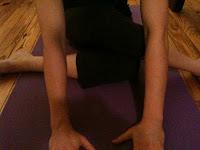Guest Blogger, Adam Kazan
Ashtanga Alien Predator and What Is
Part 2 of 2
"you can't be anyone but you
therefore you are that Other one you love"
- Ikkyu
Now back to how this all has to do with Ashtanga practice? The real question is why and how we are not with what is... basically what makes us travel away from reality and ourselves? What is our relationship with that which we dislike and that which we want? And all those lovely distractions that assist (3Xper netflix, no cable). From where do these crafty creatures come from? What we repress and not acknowledge arises as Frankenstein, the creature from the black lagoon, hellraiser, sex and the city, racism. We then want to further wall ourselves off from these invaders, to not know our own suffering.
How do we release ourselves from this bondage of our own entrapment? Traditionally and presently it comes from various seemingly spiritual techniques. Like prayer, meditation, yoga, good deeds, mindfulness. Do these work...hummm? What do you think? These methods seem to make us face the suffering. There is a tale that on Buddha's ("life is a chockablock pain") deathbed he said "Work out your salvation with diligence." Yes your very own salvation. What does it take for you, yes the specific you, to wake up a bit more. Different methods for different people. Find yourself shoes that fit.
A 10-day retreat spent with violent turning nonaggresive extraterrarestials is a very particular environment, a special container for awareness. A daily practice of Ashtanga yoga is a daily training of awareness, the paying attention to what is actually happening. Ashtanga is a great way to make this happen for oneself. The force of this yoga brings my mind to reach the mechanisms of how my body is working. It brings an integration and cohesion to the mind body connection. It is an efforted training to be with the body and find out what is there. Yet....
What happens most of the time with my mind... wander and wonder. It goes away from the body, it looks about and gets interested in what is not. Those outer space visitors have all kinds of interesting ways to seek my attentions. My two favorite mind wanderers during practice is clock watching and looking at who is coming into the studio. Practice is a great place to notice the habits of the mind for distraction. Noticing the habits allows for a little more spaciousness. Those spaces give room for different choices.
Ashtanga gives me the opportunity to train the mind and body to pay attention and be focused. After a year and half of steady practice I now stay focused about 10%+ of the time, an over 150% improvement from when I started. What do I get with that...a little more awareness of the outcomes of my actions, a bit more healthy, a bit more spry, a tiny bit more compassion and as an ex-girlfriend said about me "you are less of a jerk." Overall great success.
In a way this practice helps you be you.











 Dr. Blackburn worked with Dean Ornish and others on a
Dr. Blackburn worked with Dean Ornish and others on a